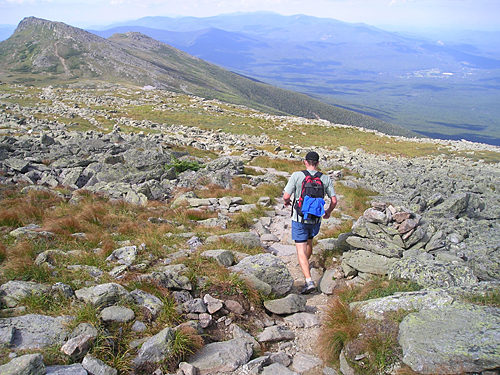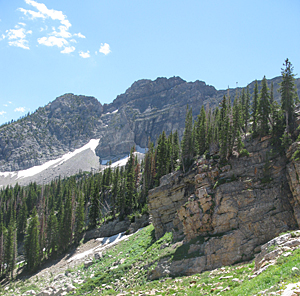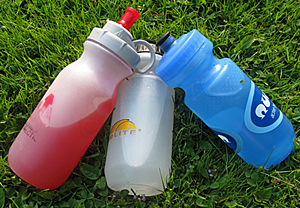
Whether you’re hiking, backpacking, trail running, or fastpacking, poor hydration can ruin a day on the trail.
Mild dehydration can make you feel plain sick and tired and hinder performance. Severe dehydration can lead to serious complications, including organ failure, coma, and even death, if not treated promptly.
So, it’s important to monitor your fluid levels before, during, and after your time on the trail, year round and in all conditions.
- Dehydration: signs and symptoms
- Find your sweat rate
- Weather watch
- Water vs. sports drinks
- Hydration guidelines
Dehydration
The old drink-eight-glasses-a-day rule (64-80 ounces) is based on a sedentary individual. So trail buffs need more liquid than that when running, hiking, or backpacking, a lot more. They also need to monitor their hydration much more closely.
Keep in mind that 75 percent of your muscles, 90 percent of your brain mass, and 60 to 70 percent of your entire body are made up of water (the specific amount depends on your body composition). If you lose more fluids through sweat, breath, or urine than you take in the result is dehydration.
Dr. Shawn Talbott is well versed on the ins and outs of fueling while exercising. He has earned a Ph.D. in nutritional biochemistry and an M.S. in exercise science. In addition to his academic credentials, Talbott is the research director of Supplement Watch as well as an Ironman and an ultra marathoner.
Talbott’s explanation of why it’s important to hydrate efficiently when you’re out on the trails is fairly simple: “When you get too dehydrated, you aren’t able to cool your body effectively and then you get into risks such as heat exhaustion or heat stroke. Before you get to those safety issues, however, you’re definitely going to see a drop in performance.”
Sweat Rate
Most people sweat between 27.4 to 47.3 ounces for each hour of exercise, but the amount is individual and highly variable. Talbott says you can sweat off about five percent of your body weight before you hit the danger zone, but dehydration symptoms begin with a one to two percent loss.
“As little as one percent means that you’re going to start losing performance,” explains Talbott. Since a pint of fluid weighs one pound, that’s a 1.6-pound loss for a 160-pound individual. That amount can be lost quickly on a hot day. This is why many trail races have weigh-in stations to monitor the runners’ hydration levels throughout the race.
To determine how much fluid you need to take in, first consider your individual sweat rate.
To calculate your sweat rate:
- Weigh yourself naked before you hit the trails for your regular activity: hike, run, walk, bike.
- Keep track in ounces of any fluids you ingest during your activity and for how long you exercise (exercising for an hour will make for easy math, but you can pick the duration).
- Afterward, wipe off all your sweat and weigh yourself again, naked and dry.
- Find the difference between your before and after weights. Account for any ounces you drank by adding them to your total weight loss or subtracting them from a weight gain.
“The rule of thumb is for every pound that you lose in body weight, you’ve sweated off a pint, or sixteen ounces, of liquid,” says Talbott.
So, a two-pound weight loss during an hour of trail running would mean you lost 32 ounces of fluid (2 lbs x 16 ounces), plus the 10 ounces of water you drank, for a total loss of 42 ounces. That’s your sweat rate for that activity level in those conditions: 42 ounces/hour of trail running.
To get the best understanding of your own sweat rate try the test during different conditions and activities.
Weather Watch

Altitude, heat, and humidity all factor into hydration.
Weather and climate factor into hydration year round. Whether you’re hiking in the Grand Canyon at the height of summer or skiing in the Arctic in the dead of winter, hydration is equally important. It is particularly easy to underestimate how much fluid the body needs when it’s cold. Cold, dry air causes you to lose moisture through every exhalation, so there is less sweat, giving you a false sense of hydration.
Heat and humidity are the most commonly blamed causes of dehydration. Heat simply causes you to sweat more. Humidity, however, poses another threat. Talbott explains, “the problem with being in a humid environment is that you’re still going to sweat a lot, but it’s going to drip off you instead of evaporate. You aren’t going to get the cooling effect from sweat evaporating from your skin, so your body isn’t going to cool down and it’s going to sweat more.” Since the internal cooling mechanism isn’t as effective, a nasty cycle of over-sweating develops.
When combined together heat and relative humidity make up the heat index, a measure of perceived heat or how hot it feels. On very hot or high heat index days, try to hit the trails in the cooler mornings or late-afternoons and evenings.
In addition to climate, altitude also affects your hydration. At higher elevations (generally considered above 8,000 feet) your body may try to adjust by increasing your urine output and your breathing rate, causing you to exhale more water vapor. Since dehydration develops more rapidly at higher elevations, consider drinking more liquids than usual, especially if you haven’t been living or training at that elevation. Your body can acclimate to both temperature and altitude; however, it can take days or weeks to do so. Always remain diligent when it comes to hydration in unfamiliar conditions.
Water vs. Sports Drinks

Water is good, but drinks with electrolytes are even better, especially if you’re out for more than one hour.
Debating the effectiveness of water versus sports drinks can be heated in some circles. The American College of Sports Medicine recommends that anyone exercising longer than one hour consume a sports drink, preferably one with at least 110 milligrams of sodium per 8 ounces of liquid.
Talbott agrees that water is good for hydration out on the trails, but sports drinks are better, particularly for longer duration activities at higher intensities.
Electrolytes are the key. These include sodium, chloride, potassium, and sometimes magnesium. The small amounts of electrolytes in sports drinks became ions in a solution and assist the body with the uptake of water, leading to quicker absorption and more effective retention of liquids.
“There is no ‘best’ electrolyte blend out there,” Talbott says, “pretty much all of those electrolyte drinks, whether it’s Gatorade, Powerade, or Accelerade, are all pretty equivalent to each other.” He goes on to explain that “the carbs are important because in a Gatorade-style hydration drink, it’s the combination of a little bit of sugar and a little bit of electrolytes that enhance the hydration effect of that beverage. These drinks are clearly better than plain water.”
While dehydration is far more common, it is possible to drink too much water. This rare condition occurs when a dehydrated person, such as an endurance athlete, drinks too much water without adding back the necessary electrolytes. The result is water intoxication and hyponatremia, the excessive dilution of sodium in the body.
If you’ re only active for a short while and/or not that strenuously, water can still do the job, particularly if you also snack on foods that help replace electrolytes. But, when you are browsing the sports drink/powder aisle, look for sodium, chloride, potassium, and sugar on the nutrition label.
Those who want or need to avoid the sugar in sports drinks can select from several brands of water-dissolvable electrolyte tablets (nuun and CamelBak’s Elixir are two examples). Another option is to make your own sports drinks. Recipes abound online, it’s less expensive, and you can tailor the drink to your own nutritional needs and tastes.
Whichever options you choose, test your sports drinks out before committing to one on a multi-day backpacking trip. And, if you’re more likely to drink a certain sports drink or water while on the trail, take that one along or switch between two. Electrolytes are necessary, but you need to drink them first to do the job.
Practical Hydration Guidelines
So, how much do you need to drink?
A body can only absorb so much fluid while exercising, on average 24 to 32 ounces per hour, though some people fall above or below this range. This means you may be unable to consume enough fluids while you’re on the trails to replace what you’ve already lost. This is particularly true for endurance athletes (remember our example above of a 42-ounce loss per hour while trail running?).
If you’ve determined your sweat rate and know you have lost five pints of fluid, guzzling five pints of Gatorade all at once will only serve to upset your stomach. Because the GI tract can only handle so much liquid when running trail runners tend to be less hydrated than hikers. Talbott says, “you just can’t put enough fluid into your body to completely keep yourself even. The best thing you can do is put a dent in it.”
To help keep your body in balance, first start out hydrated. While every individual’s hydration needs differ, you ideally should try to drink 10 to 25 ounces (250-750 ml) of a sports drink and/or water two to three hours before you begin exercise.
An hour before, drink 10 to 18 ounces (350-500 ml) of plain water, since it’s less likely to bother your stomach. In a perfect world you should consider consuming another 8 to 10 ounces (250 ml) of water right before you start your activity.
If you will be hitting the trails for longer than one hour aim to consume 8 to 10 ounces (200-250 ml) of a sports drink with electrolytes every 15 to 20 minutes. Talbott describes his own routine saying, “I try every 15 minutes to take two really good mouthfuls from my bottle. That works for me. I don’t ever feel like I have a full stomach, but I’m constantly taking something into my body.”
For long day hikes and backpacking trips where you can’t carry in all your water, plan your water stops ahead of time from available sources. Start any outing with a full supply of water, factoring in the route’s difficulty, length, and the weather. Don’t pass up water when hiking or backpacking, especially if conditions are very dry and/or hot. Make sure everyone in your group, especially children, has easy and frequent access to their water/drinks with handy water bottles or a hydration reservoir. Remember, prevention is the best treatment for dehydration. It’s better to sip regularly than to try to chug your way back to hydration.
Hydration is paramount at any time of year, whether you are out backpacking, hiking, trail running, or fastpacking. Experiment with different hydration routines to figure out what works best for you. Keep in mind that thirst is a poor indicator of dehydration. If you are thirsty, you are likely far beyond the beginning stages of dehydration.
When you finish up on the trail, remember to begin rehydrating immediately. While mild dehydration may be impossible to avoid completely, it can be combated and beaten back with the proper amount of water and electrolytes. Your muscles and brain need liquid fuel. Give your body plenty of what it needs—hydration.

 by Mackenzie Lobby
by Mackenzie Lobby









